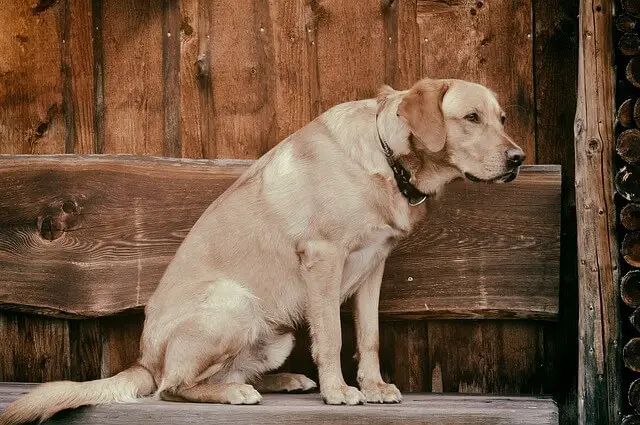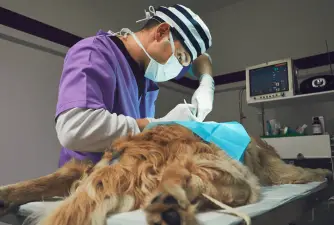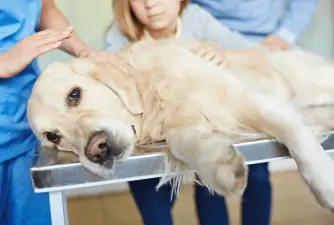Bone Cancer in Dogs - Signs & Treatment
18.11.2021.
There’s nothing more we would love than our dogs to live as long as we can. Unfortunately, that is impossible. Like us, dogs are prone to different diseases that can significantly shorten their lifespan. One of those nasty diseases is bone cancer. If you have a senior dog and you suspect they might develop this disease, here’s what you should know about bone cancer in dogs.
What is bone cancer in dogs?
The name is pretty self-explanatory. Bone cancer is also called osteosarcoma (osteo=bones, sarcoma=cancer), and it is an aggressive type of cancer that develops on the dog’s bones. In short, it is a malignant tumor of the bone. This type of cancer most commonly affects the dog’s long bones like arms and legs. However, hips, jaws, and pelvis bones can be affected as well.
This type of cancer is sneaky, and it can even affect parts of the body that are not necessarily bones. Bone cancer can develop even on non-bony tissue such as mammary glands, kidneys, spleen, and liver. If that happens, that specific type of osteosarcoma in dogs is called extraskeletal osteosarcoma.
What causes it?
Unfortunately, with all the modern veterinary medicine research and advancement, we still don’t entirely understand cancer. We don’t know why it develops or what exactly causes it. It can be genetic, which means that dogs that developed bone cancer should be excluded from breeding. However, since this form of cancer affects older dogs, excluding them from breeding is often impossible. It is most likely that the exact reason for osteosarcoma is a mix of environmental and genetic risks.

What we do know is that bone cancer develops because the cells that are in charge of creating and breaking down bones mutate. These cells are called osteoblasts (creating bone) and osteoclasts (breaking down bone). These cells will start an abnormal production and result in bone cancer in dogs.
How can I know if my dog has bone cancer?
Most dog owners don’t know right away their dog has bone cancer. In fact, if you’re not a veterinarian, it can be pretty hard to accurately diagnose cancer in dogs. Most dog owners notice something’s wrong with their dogs, and they decide to take them for a checkup. Since this type of cancer is most common in older dogs, most owners are primarily afraid of arthritis or other issues connected to age. However, giant and large dog breeds seem more prone to it. If you have such a dog at home, you should learn the bone cancer symptoms.
Symptoms of bone cancer in dogs
Like with any other disease, bone cancer in dogs will cause specific symptoms. If you know what they are and you have a breed prone to this form of cancer, you should be careful and make sure you keep an eye on your dog. If you notice something’s off with your dog’s demeanor or gate, you should take them for a checkup. The most common symptoms of bone cancer in dogs are;
- Lameness
- Lethargy
- Pain in affected limbs
- Swelling
- Loss of appetite
- Loss of interest in playing or walking

Breeds prone to bone cancer
After a vast number of bone cancer cases, vets and researchers managed to draw some conclusions regarding this disease. They noticed that specific breeds are prone to developing it. Bone cancer is most common in giant and large dog breeds. Those breeds are;
- Boxers
- Great Pyrenees
- Greyhounds
- Saint Bernards
- Rottweilers
- Labrador Retrievers
- Irish Setters
- Irish Wolfhounds
- Great Danes
- German Shepherd Dogs
- Dobermans
How is it diagnosed?
The first thing your vet will examine is the affected part of the dog’s body. Most dogs will have a swelling that is incredibly warm because cancer will cause lameness and inflammation. The affected area should be relatively warm. After that, the vet might suspect bone cancer, but they will still need definitive proof.
The second step is x-rays. Vets will order x-rays because they want to make sure what area is actually affected. If the dog has bone cancer, the picture will appear moth-eaten. The bone will seem like it’s missing pieces.

The last step and the most definitive diagnosis can be obtained with fine needle aspiration. The vet will take a small fine needle, take a cell sample, and observe them under a microscope. If that test ends up inconclusive, the vet will order a bone biopsy. That should give them conclusive enough evidence and a correct diagnosis.
How is bone cancer in dogs treated?
If there is no evidence of metastasis, the primary goal of your vet will be to localize cancer. The vet will determine which parts of the dog’s body are infected, and if the tumor is localized in one limb, the most common treatment option is amputation. This might be scary for humans, but dogs deal really well with amputations.
The second step of the treatment is chemotherapy. Again, humans don’t really do well with chemo. We can lose hair, vomit, and have all sorts of side effects. However, dogs do pretty well with chemo. In most cases, the only side effect dogs get is vomit. Postoperative tumor control is important. The vet will want to keep a close eye on the dog and ensure cancer doesn’t return.
What is the prognosis?
The prognosis will entirely depend on the stage of cancer. If the bone cancer in dogs is caught early, the prognosis can be pretty good. The vet will most likely recommend amputation, and as we already said, dogs do pretty well with amputations. However, many cases of bone cancer in dogs are discovered too late. If that happens, it’s most likely cancer already spread. In that case, the prognosis is not that good.
World Dog Finder team



![Best Dog DNA Tests [Most Accurate]](https://worlddogfinder.com/imager/334x225/upload/articles/mixed_dog_cloesup.jpg)



Share